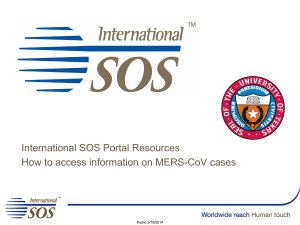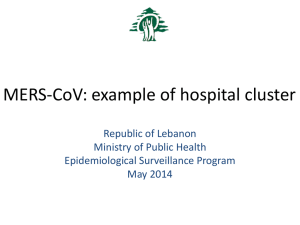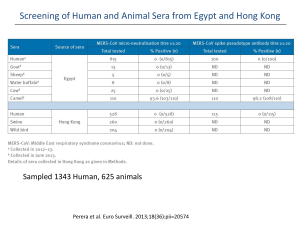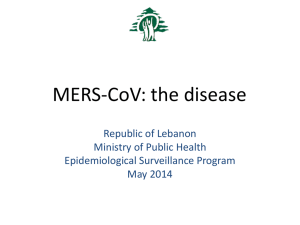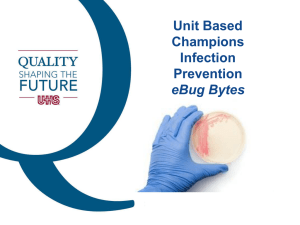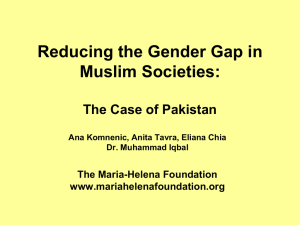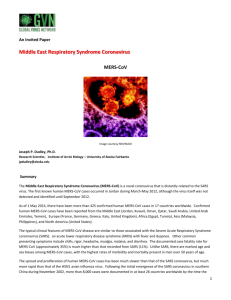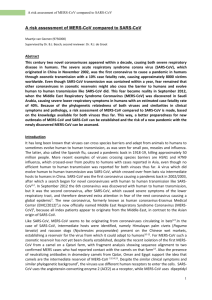Middle East respiratory syndrome (MERS) coronavirus
advertisement
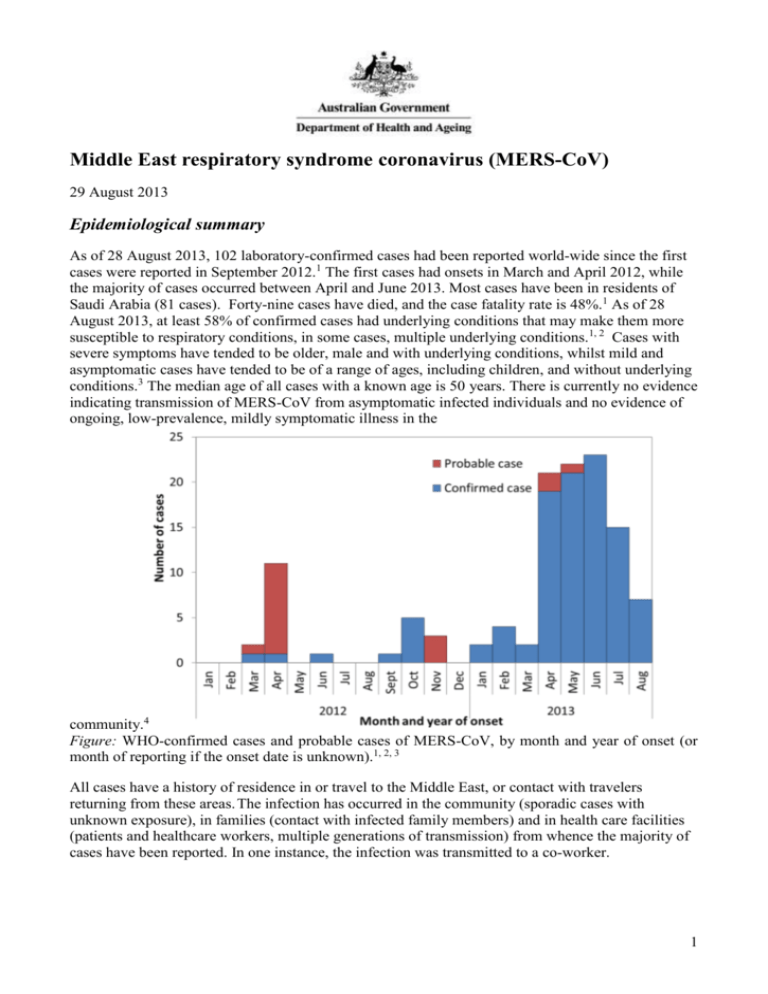
Middle East respiratory syndrome coronavirus (MERS-CoV) 29 August 2013 Epidemiological summary As of 28 August 2013, 102 laboratory-confirmed cases had been reported world-wide since the first cases were reported in September 2012.1 The first cases had onsets in March and April 2012, while the majority of cases occurred between April and June 2013. Most cases have been in residents of Saudi Arabia (81 cases). Forty-nine cases have died, and the case fatality rate is 48%.1 As of 28 August 2013, at least 58% of confirmed cases had underlying conditions that may make them more susceptible to respiratory conditions, in some cases, multiple underlying conditions.1, 2 Cases with severe symptoms have tended to be older, male and with underlying conditions, whilst mild and asymptomatic cases have tended to be of a range of ages, including children, and without underlying conditions.3 The median age of all cases with a known age is 50 years. There is currently no evidence indicating transmission of MERS-CoV from asymptomatic infected individuals and no evidence of ongoing, low-prevalence, mildly symptomatic illness in the community.4 Figure: WHO-confirmed cases and probable cases of MERS-CoV, by month and year of onset (or month of reporting if the onset date is unknown).1, 2, 3 All cases have a history of residence in or travel to the Middle East, or contact with travelers returning from these areas. The infection has occurred in the community (sporadic cases with unknown exposure), in families (contact with infected family members) and in health care facilities (patients and healthcare workers, multiple generations of transmission) from whence the majority of cases have been reported. In one instance, the infection was transmitted to a co-worker. 1 Background In September 2012, a novel human coronavirus, now named MERS-CoV, was identified in two patients with severe respiratory disease; one from Saudi Arabia and one from Qatar. Cases were retrospectively confirmed in two deceased persons from Jordan who were part of a cluster of 11 cases of severe lower respiratory infection in a hospital between March and April 2012, but none of the other cases could be confirmed. Signs and symptoms Most confirmed cases have presented with, or later developed, acute, serious respiratory tract disease. Typical symptoms have included fever, cough and breathing difficulties. Of the first 47 cases in Saudi Arabia, 89% (42 cases) required management in intensive care, and 72% (34 cases) required mechanical ventilation.2 All cases had abnormal chest radiographs.2 The most frequently reported symptoms were; fever (46 cases, 98%), cough (39 cases, 83%), shortness of breath (34 cases, 72%), myalgia (15 cases, 32%) diarrhea (12 cases, 26%), nausea (10 cases, 21%) and vomiting (10 cases, 21%).2 A range of other symptoms were reported, each with a frequency of 17% or less.2 A case that was transferred from the UAE to Germany in March 2013 had initial symptoms of rapid onset of ILI and a non-productive cough, progressing to pneumonia on day 2, thrombocytopaenia and on day 14, renal insufficiency requiring dialysis, and death on day 18 was from septic shock.5 The number of reported cases who are asymptomatic cases or have mild symptoms has increased recently. There have been at least 15 such cases identified through contact tracing in late June and in July 2013, including four health-care workers in Saudi Arabia.1, 3 Earlier in the outbreak, a case in the UK had only a mild, self-limiting illness.6 A probable case in a family cluster in Saudi Arabia had only a mild self-limiting illness, but upper respiratory tract swabs were negative for the infection.7 Milder ILI was also reported in probable secondary cases in the cluster centred on a hospital in Saudi Arabia.8 An immunocompromised patient in France presented with atypical symptoms; fever and diarrhoea in the absence of respiratory symptoms, but with radiological evidence of pneumonitis.9 Renal insufficiency or failure has been noted for many MERS patients; however, it is unclear whether the renal insufficiency or failure is due to the infection, or may be contributed to by anti-microbial agents and other medications used in treatment, or whether perhaps it influences disease progression, or some combination of these. Four of the first eight reported cases in Saudi Arabia were reported to have had renal failure in addition to respiratory failure, and both of the patients in France were reported to have had renal failure as was a case transferred to Germany from the UAE.5, 9, 10 The cluster in a hospital in Saudi Arabia was centred on a dialysis unit, and 13/25 probable and confirmed cases had end stage renal disease.8 Susceptibility There is an increasing trend of severe cases of MERS-CoV infection in older patients with underlying conditions, and milder cases in their contacts who do not have underlying conditions. In the first 47 cases of MERS-CoV infection in Saudi Arabia, 60% of cases had any underlying comorbidity, most frequently; diabetes (32 cases, 68%), chronic kidney disease (23 cases, 49%), chronic heart disease (13 cases, 28%), hypertension (16 cases, 34%) chronic lung disease (12 cases 26%).2 UK case 2 had an underlying malignancy that was likely to have resulted in immunosuppression.6 Saudi case 2 had diabetes and cardiovascular disease, and the index case in France was a renal transplant recipient.9 None of the 11 mild or asymptomatic cases in June and July 2013 for whom information is available were reported to have underlying conditions.1 2 In the cluster in the UK, the index case was infected with influenza, and the two secondary cases with parainfluenza type 2.6 It is unclear whether these infections may influence susceptibility, transmissibility or the clinical course of the disease. The high case-fatality rate may reflect the vulnerability of patients with underlying conditions to respiratory infection (as observed in Canada during the SARS outbreak where co-morbid conditions were independently associated with severe outcomes11) and the difficulties in detecting milder cases that may be occurring in the community. Incubation period The incubation period for MERS-CoV is estimated to be up to two weeks, but likely shorter in most cases, however more data are required to refine the estimates. The estimation of the incubation period is complicated by a number of factors; community acquired cases have been infected from unknown sources, clusters are complicated by multiple exposures to the index case, and there is the possibility of tertiary cases. The presence of respiratory infections other than MERS-CoV may also complicate the estimation of incubation period, where the date of onset for MERS-CoV, as opposed to symptoms due to the co-infection is unclear. For a hospital-associated cluster in Saudi Arabia, the incubation period of confirmed cases ranged between a possible one day and 12 days, and was estimated* to have been 5.2 days, with a 95% confidence interval of 1.9 to 14.7 days.8 Other data support an incubation period of up to 12 days, particularly based on a patient who acquired the infection in a hospital room in Lille, France, for whom the incubation period was estimated to have been between 9 and 12 days.9 Clusters and transmissibility Clusters of infection in healthcare and family settings and in a workplace have confirmed that person-to-person transmission of the virus is occurring,6, 7, 8, 9 but the particular conditions, procedures or situations that facilitate spread, and the role of any community transmission are not well known. Known clusters to date have been: * Jordan – April 2012, 2 confirmed cases, 9 probable cases in a healthcare setting.12 Saudi Arabia – October 2012, 3 confirmed cases and 1 probable case in a family.7 Saudi Arabia – February 2013, 3 cases in a family in Riyadh. United Kingdom – February 2013, 3 cases, one returned traveller from Pakistan and Saudi Arabia, and his two adult children.13 Saudi Arabia – April-May 2013, 23 confirmed and 11 probable cases, hospital associated, Al-Ahsa, Eastern Province.8 France – May 2013, 2 cases one returned traveller from Dubai, United Arab Emirates and hospital contact in Lille, France.9 Tunisia – May 2013, 1 probable case in a traveller returning from Saudi Arabia, 2 confirmed cases in family members, one of them who travelled to Tunisia from Qatar, and the other who was a resident of Tunisia. Italy – May 2013, 1 confirmed case in a traveller returning from Jordan, 2 confirmed cases in contacts (niece and co-worker). United Arab Emirates – July 2013, one case in a man with underlying conditions who had Maximum likelihood estimation methods 3 contact with domestic animals, and four health-care workers who had contact with the man while he was in hospital.14 Extensive contact tracing in the UK suggested that the virus was not very transmissible from person to person, with only two of the 92 close contacts of the index case testing positive.6 In Germany, a patient that was transferred from Qatar was hospitalised for nearly a month prior to diagnosis, at which time infection control measures were put in place. This resulted in potential exposure for a considerable number of healthcare workers, including nine who performed aerosol-generating procedures, but none of the 85 screened were positive for MERS-CoV by serological tests.15 Difficulties in detecting milder or asymptomatic cases may be contributing to these findings. In a hospital outbreak in Saudi Arabia, MERS-CoV was found to have spread over four generations of transmission.8 The infection spread from a single ward in the hospital to another ward, to two other units within the hospital, and to two other separate hospitals.8 The recent report of eight asymptomatic cases in Saudi Arabia, and the likelihood of multiple generations of transmission in a hospital cluster may indicate the possibility of higher transmissibility than previously described and undetected community transmission. It is important to note that a very large number of people have been identified and tested during contact tracing in Saudi Arabia, so the percentage positive would be very small. In Saudi Arabia, seven healthcare workers with mild or asymptomatic infections acquired through contact with MERS-CoV patients provide some indication about the conditions in hospitals that may have allowed spread to occur. None of the seven wore eye protection whilst in contact with the patients, 3/7 didn’t wear gloves and 2/7 didn’t wear a mask, and these healthcare workers placed catheters and were present during intubation.16 Failure to follow infection control guidelines may have allowed the virus to spread in these instances. The basic reproductive number (Ro) is a measure of the number of secondary infections per index case in a fully susceptible population, with an Ro >1 required for sustained transmission in a population, and at that point, the organism has epidemic potential.17 In a Bayesian analysis for 55 of the first 64 laboratory-confirmed cases of MERS-CoV infection, the Ro has been estimated to be 0.69 (95% CI 0.50–0.92) under one scenario, and 0.60 (95% CI 0.42–0.80) under another, contrasting with the pre-pandemic Ro for SARS of 0.80 (95% CI 0.54–1.13) .17 Thus MERS-CoV is considered unlikely to cause a pandemic at present. Source of sporadic infections MERS-CoV is a Betacoronavirus (the genus that contains SARS), but of the lineage C, which includes viruses from bats, and does not include SARS.18 MERS-CoV appears to be most similar to a virus isolated from a Neoromicia bat caught in South Africa, and also similar to viruses isolated from Pipistrellus bats in the Netherlands and Tylonycterus bats.18, 19, 20, 21 MERS-CoV was also detected in dropping of the bat droppings of the bat species Taphozous perforatus collected near the home and workplace of a sporadic case in Saudi Arabia.22 Whilst bats appear to be the natural host of the virus, bats are not necessarily the immediate source of the infections. It is unlikely that many of the patients had contact with bats, and the possibility that a single spill over event occurred to an intermediate animal host species, subsequently leading to human infections is more likely.23 Phylogenetic data indicate that the first human infections may have occurred sometime in 2011 and there is some phylogenetic clustering depending on the country of acquisition.5 4 Little information is available on the possible exposures for sporadic cases, including a paucity of published data on contact with animals. Researchers found MERS-CoV specific IgG in 100% (50/50) of serum samples from female Omani racing dromedary camels and 14.3% (15/105) of samples from camels in the Canary Islands (Spain), whilst sera from a range of other livestock (European, not Middle Eastern) were negative.24 There was no known increase in morbidity amongst the camel populations from which the samples were drawn.25 These results suggests that MERS-CoV or a closely related virus may have been widely circulating amongst camels in Oman and possibly elsewhere. Further work is required to understand the implications of these results for human cases, including reviewing the links between any human cases and any animal exposures.24 Laboratory testing Laboratory confirmation of MERS-CoV infections to date has largely been by real-time reverse transcription polymerase chain reaction (rRT-PCR) of lower respiratory tract specimens. Viral loads for MERS-CoV in analysed lower respiratory tract secretions for a patient treated in Germany in March 2013 were high 12 days after onset (the first samples available), and appeared to decline over the following six days, but still well above detection limits.5 Fresh bronchoalveolar aspirates appeared to be the most reliable sample for MERS-CoV rRT-PCR .5 In France, repeated assays and sampling showed the that there is the possibility of negative or inconclusive results on upper respiratory tract specimens with low viral loads compared with sputum collected at the same time point which may test positive, with very high viral loads.9 Throat swabs appeared to be unreliable in a hospital associated outbreak in Saudi Arabia.8 Upper respiratory tract specimens may not be as useful for confirming the infection by rRT-PCR, however two cases in the UK were PCR positive on throat/nasopharyngeal swabs.6, 7, 26 The United States Centers for Disease Control and Prevention recommends that lower respiratory tract specimens be a priority for collection and PCR testing, and that samples should be collected at a range of times post-onset.27 Stool samples were widely used during SARS for diagnosis,28 but to date, there is only limited data on the utility of stool samples for diagnosing MERS. Stool samples collected on days 12 and 16 for a patient transferred to Germany in March 2013, were PCR positive, but the RNA concentrations were close to the lowest limit of detection.5 It is unclear whether the patient in Germany had diarrhoea at the time of collection for samples that were PCR positive. Stool samples collected on day 23 from a patient transferred to the UK were negative by rRT-PCR.26 Whilst diarrhoea has been listed in the clinical picture for other cases, including in two separate clusters in Saudi Arabia,7, 8 no testing has been undertaken. Urine samples from a patient transferred to Germany in March 2013 were rRT-PCR positive on days 12 and 13, but not on day 14.5 RNA concentrations were higher in urine than in stool for at least one sample.5 Immunofluorescence assays appeared to be useful to detect antibody to MERS-CoV in both acute and convalescent sera from a patient in Germany and from an experimentally infected macaque.29 Whilst there were no false positives in a limited number of people who were not thought to have been exposed, further work is needed to validate the assay.29 The assay detected antibodies when the patient still had virus detectable by rRT-PCR in respiratory secretions. A Western blot was used for confirmation, with good correlation between the results of these two methods.29 Contacts of the case of MERS-CoV that was imported to Germany were screened using a two-stage testing; indirect immunofluorescence assay, followed by serum neutralisation tests.15 While one of 85 blood samples was reactive for IgM and another for IgG at low dilutions, specific novel coronavirus antibodies were ruled out by immunofluorescence assay.15 5 On 7 June 2013, the WHO reported that 8 of the 124 specimens collected during investigation of the 2012 outbreak in Jordan (see clusters above) were positive by serology (enzyme immunoassay and immunofluorescence assay).30 Six of these eight were considered probable cases in the outbreak investigation in April 2012. These are not included within the number of confirmed cases being reported by the WHO. Serological tests are not currently available for testing suspected cases in Australia. Further information The latest case counts and documents related to MERS-CoV are available from the WHO: Coronavirus infections – (www.who.int/csr/disease/coronavirus_infections/en/) The WHO has issued advice to travellers on MERS-CoV Middle East respiratory syndrome - coronavirus (MERS-CoV) – Update – (www.who.int/ith/updates/20130605/en/index.html) CDNA advice to clinicians, laboratories and public health personnel and to GPs, as well as a fact sheet for consumers/patients are available from: the Department's website – (www.health.gov.au/mers-coronavirus) The Ministry of Health recommendations about the Hajj can be found at: Health Regulations for travellers to Saudi Arabia for Umrah& Pilgrimage (Hajj)-1434 (2013) (http://www.moh.gov.sa/en/Hajj/Pages/HealthRegulations.aspx) References 1. World Health Organization. Middle East respiratory syndrome coronavirus (MERS-CoV) updates 23 September 2012 to 28 August 2013. 2. Assiri A, Al-Tawfiq JA, Al-Rabeeah AA, Al-Rabiah FA, Al-Hajjar S, Al-Barrak A, et al. Epidemiological, demographic, and clinical characteristics of 47 cases of Middle East respiratory syndrome coronavirus disease from Saudi Arabia: a descriptive study. Lancet Infect Dis 2013. 3. World Health Organization. Middle East respiratory syndrome coronavirus (MERS-CoV) summary and literature update as of 9 July 2013. 2013. 4. World Health Organization. Middle East respiratory syndrome coronavirus Joint Kingdom of Saudi Arabia/WHO mission. 2013. 5. Drosten C, Seilmaier M, Corman VM, Hartmann W, Scheible G, Sack S, et al. Clinical features and virological analysis of a case of Middle East respiratory syndrome coronavirus infection. Lancet Infect Dis 2013. 6. The Health Protection Agency (HPA) UK Novel Coronavirus Investigation team. Evidence of person-to-person transmission within a family cluster of novel coronavirus infections, United Kingdom, February 2013 Euro Surveill 2013;18(11). 7. Memish ZA, Zumla AI, Al-Hakeem RF, Al-Rabeeah AA, Stephens GM. Family Cluster of Middle East Respiratory Syndrome Coronavirus Infections. N Engl J Med 2013. 6 8. Assiri A, McGeer A, Perl TM, Price CS, Al Rabeeah AA, Cummings DA, et al. Hospital Outbreak of Middle East Respiratory Syndrome Coronavirus. N Engl J Med 2013(369):5. 9. Guery B, Poissy J, El Mansouf L, Sejourne C, Ettahar N, Lemaire X, et al. Clinical features and viral diagnosis of two cases of infection with Middle East Respiratory Syndrome coronavirus: a report of nosocomial transmission. Lancet 2013. 10. Memish Z, Alhakeem R, Stephens G. Saudi Arabia and the emergence of a novel coronavirus. East Mediterr Health J 2013;19(Supplement 1):S7-S11. 11. Booth C, Matukas, L., Tomlinson, G., et al. Clinical features and short-term outcomes of 144 patients with SARS in the greater Toronto area. JAMA 2003;289(21):2801-2809. 12. Hijawi BA, M., Sayaydeh, A., et al,. Novel coronavirus infections in Jordan, April 2012: epidemiological findings from a retrospective Investigation. East Mediterr Health J 2013;19(Supplement 1). 13. Wise J. Two more cases of novel coronavirus are confirmed in UK. BMJ 2013;346:f1030. 14. World Health Organization. Middle East respiratory syndrome coronavirus (MERS-CoV) update 18 July 2013. 2013. 15. Buchholz U, Müller MA, Nitsche A, Sanewski A, Wevering N, Bauer-Balci T, et al. Contact investigation of a case of human novel coronavirus infection treated in a German hospital, OctoberNovember 2012. Euro surveillance: bulletin européen sur les maladies transmissibles= European communicable disease bulletin 2013;18(8). 16. Memish Z, Zumla, Alimuddin I., Assiri, A.,. Middle East Respiratory Syndrome Coronavirus Infections in Health Care Workers. The New England Journal of Medicine 2013. 17. Breban R, Riou J, Fontanet A. Interhuman transmissibility of Middle East respiratory syndrome coronavirus: estimation of pandemic risk. Lancet 2013. 18. van Boheemen S, de Graaf M, Lauber C, Bestebroer T, Raj V, Zaki A, et al. Genomic characterization of a newly discovered coronavirus associated with acute respiratory distress syndrome in humans. mBio. 2012; 3 (6): e00473-12. In; 2012. 19. Cotten M, Lam TT, Watson SJ, Palser AL, Petrova V, Grant P, et al. Full-genome deep sequencing and phylogenetic analysis of novel human betacoronavirus. Emerg Infect Dis 2013;19(5). 20. Annan A, Baldwin H, Corman V, Klose S, Owusu M, Nkrumah E, et al. Human betacoronavirus 2c EMC/2012–related viruses in bats, Ghana and Europe. Emerg Infect Dis 2013. 21. Ndapewa Laudika Ithete SS, Victor Max Corman, Veronika M. Cottontail, Leigh Rosanne Richards, M. Corrie Schoeman, Christian Drosten, Jan Felix Drexler, and Wolfgang Preiser. Close Relative of Human Middle East Respiratory Syndrome Coronavirus in Bat, South Africa. Emerging Infectious Diseases 2013;19(10). 22. Memish ZA MN, Olival KJ, Fagbo SF, Kapoor V, Epstein JH, et al.,. Middle East respiratory syndrome coronavirus in bats, Saudi Arabia. . Emerg Infect Dis 2013 (November). 23. de Groot RJ, Baker SC, Baric RS, Brown CS, Drosten C, Enjuanes L, et al. Middle East Respiratory Syndrome Coronavirus (MERS-CoV); Announcement of the Coronavirus Study Group. J Virol 2013. 24. Reusken CB, Haagmans BL, Muller MA, Gutierrez C, Godeke GJ, Meyer B, et al. Middle East respiratory syndrome coronavirus neutralising serum antibodies in dromedary camels: a comparative serological study. Lancet Infect Dis 2013. 7 25. deWit E, Munster V. MERS-CoV:the intermediate host identified? Lancet Infect Dis 2013. 26. Bermingham A, Chand M, Brown C, Aarons E, Tong C, Langrish C, et al. Severe respiratory illness caused by a novel coronavirus, in a patient transferred to the United Kingdom from the Middle East, September 2012. Euro Surveill 2012;17. 27. Centers for Disease Control and Prevention. Update: Severe Respiratory Illness Associated with Middle East Respiratory Syndrome coronavirus (MERS-CoV) -World wide, 2012-2013. MMWR 2013;62(Early release). 28. Peiris JSM, Yuen KY, Osterhaus ADME, Stöhr K. The Severe Acute Respiratory Syndrome. New England Journal of Medicine 2003;349(25):2431-2441. 29. Corman V, Müller MA, Costabel U, Timm J, Binger T, Meyer B, et al. Assays for laboratory confirmation of novel human coronavirus (hCoV-EMC) infections. Euro Surveill 2012;17:49. 30. World Health Organization. Middle East respiratory syndrome coronavirus (MERS-CoV) update 7 June 2013. 2013. 8
